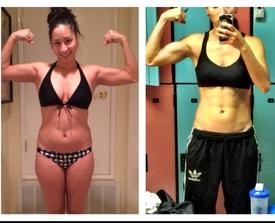Weighing salad dressing
Replies
-
Look_Its_Kriss wrote: »your scale may already come with a ML option
You can't convert from weight to volume measurements unless you know the density of the thing you're weighing, and there is no way that comes built in to a standard scale for every item you could be measuring.
OP: As others have said, volume measurements are appropriate for liquids.0 -
This content has been removed.
-
SarahStarr86 wrote: »Hello everyone! I've noticed recently learned the importance of weighing everything. Question, how would I weigh salad dressing. I use the Bolthouse Ranch and it says a serving size is 2 TBSP (which is what I've been doing) and it also gives a ML serving size but how do I weigh ML? Thanks for any suggestions!
Measure it once so you get an idea of the serving size, then from there just eyeball it.0 -
If you want to be a science geek about this stuff (sometimes I do
 !):
!):- You can convert ml to grams if you know the density of the food. Here's one calculator for converting:
onlineconversion.com/weight_volume_cooking.htm
This obviously only lists a very limited number of foods, but using something of a similar density/consistency may get you closer. - Also, the USDA nutrient database gives nutrient info (including calories) for many, many products (including Hidden Valley Ranch) in both a volume measure (like tablespoons) and a weight measurement (like grams) - look at the column headings.
https://ndb.nal.usda.gov/ndb/search/list
0 - You can convert ml to grams if you know the density of the food. Here's one calculator for converting:
-
This content has been removed.
-
I'd just like to point out that 1ml does not always equal 1g unless it's water the measuring spoon/cups will be MORE accurate than a scale in the case of liquids. Good luck x
Edit sorry didn't read all the replies saying the same thing 0
0 -
This content has been removed.
-
If you want to be a science geek about this stuff (sometimes I do
 !):
!):- You can convert ml to grams if you know the density of the food. Here's one calculator for converting:
onlineconversion.com/weight_volume_cooking.htm
This obviously only lists a very limited number of foods, but using something of a similar density/consistency may get you closer. - Also, the USDA nutrient database gives nutrient info (including calories) for many, many products (including Hidden Valley Ranch) in both a volume measure (like tablespoons) and a weight measurement (like grams) - look at the column headings.
https://ndb.nal.usda.gov/ndb/search/list
That is awesome! I basically have an abridged version of this taped to my fridge for quick calculations:
http://www.engineeringtoolbox.com/specific-gravity-liquid-fluids-d_294.html
The conversion I use the most is olive oil, which is listed as 1 TBSP (15 mL) on the label, but by weight it would be 13.5g. I don't even use measuring cups for anything anymore since the scale is way more convenient.0 - You can convert ml to grams if you know the density of the food. Here's one calculator for converting:
-
GottaBurnEmAll wrote: »I have seriously hated salad dressing of any kind until I tried the Bolthouse yogurt line. Delicious and calorie friendly? Dream come true for me.
Oh I'm so glad to hear this because I JUST bought the bolthouse creamy balsamic not knowing if it would be good or not. Whats your favorite of the yogurt line?
0 -
ThatUserNameIsAllReadyTaken wrote: »Here is how I weigh liquids. I first use a liquid measure to measure the liquid, then I weigh it to see what the weight is. I make a note of that weight and then going forward weigh the salad dressing, coffee creamer etc... so I don't have to always use measuring cups and spoons for the liquids.
This is what I do, especially for creamy/chunky dressings. It doesn't have to me a perfect representation. It just has to ne consistent.1 -
Kimblesnbits13 wrote: »GottaBurnEmAll wrote: »I have seriously hated salad dressing of any kind until I tried the Bolthouse yogurt line. Delicious and calorie friendly? Dream come true for me.
Oh I'm so glad to hear this because I JUST bought the bolthouse creamy balsamic not knowing if it would be good or not. Whats your favorite of the yogurt line?
Yes!!! I've always had to go the full fat hidden valley ranch route because nothing else has compared but ever since I've tried the Bolthouse Ranch, I've never looked back. Sooo good! I'm excited to try out more from the line.
0 -
Interestingly, I just googled and a milliliter of olive oil is only .9 grams.
Which I guess makes sense because oil is lighter than water!0 -
I always use g weighed.0
-
I'm curious, has anyone ever actually weighed a tbsp of dressing to see how close it is from the gram serving size?0
-
I'm curious, has anyone ever actually weighed a tbsp of dressing to see how close it is from the gram serving size?
I actually posted up further in the thread. This is how I do it. I measure the serving size then weigh it to get the gram weight. Some dressings have the gram weight included others do not. So that is why I have done it this way.0 -
Look_Its_Kriss wrote: »your scale may already come with a ML option
You can't convert from weight to volume measurements unless you know the density of the thing you're weighing, and there is no way that comes built in to a standard scale for every item you could be measuring.
OP: As others have said, volume measurements are appropriate for liquids.
Actually you can weigh the measured amount to see what that particular volume weighs on the food scale. This will give you an accurate weight which can be noted for future reference.0 -
_runnerbean_ wrote: »Put your salad without dressing on the scale. Reset the scale to zero (tare) then pour on your dressing. The weight will ne shown.
this is the ONLY reliable method, tare the food you are adding your dressing to them add. Just measure it in grams. 99.9% will have the nutritional value of 100g on the side of the jar. if you add 25g just divide by 4. simples!0
This discussion has been closed.
Categories
- All Categories
- 1.4M Health, Wellness and Goals
- 396.9K Introduce Yourself
- 44.2K Getting Started
- 260.9K Health and Weight Loss
- 176.3K Food and Nutrition
- 47.6K Recipes
- 232.8K Fitness and Exercise
- 454 Sleep, Mindfulness and Overall Wellness
- 6.5K Goal: Maintaining Weight
- 8.7K Goal: Gaining Weight and Body Building
- 153.3K Motivation and Support
- 8.3K Challenges
- 1.3K Debate Club
- 96.5K Chit-Chat
- 2.6K Fun and Games
- 4.5K MyFitnessPal Information
- 16 News and Announcements
- 18 MyFitnessPal Academy
- 1.4K Feature Suggestions and Ideas
- 3.1K MyFitnessPal Tech Support Questions












